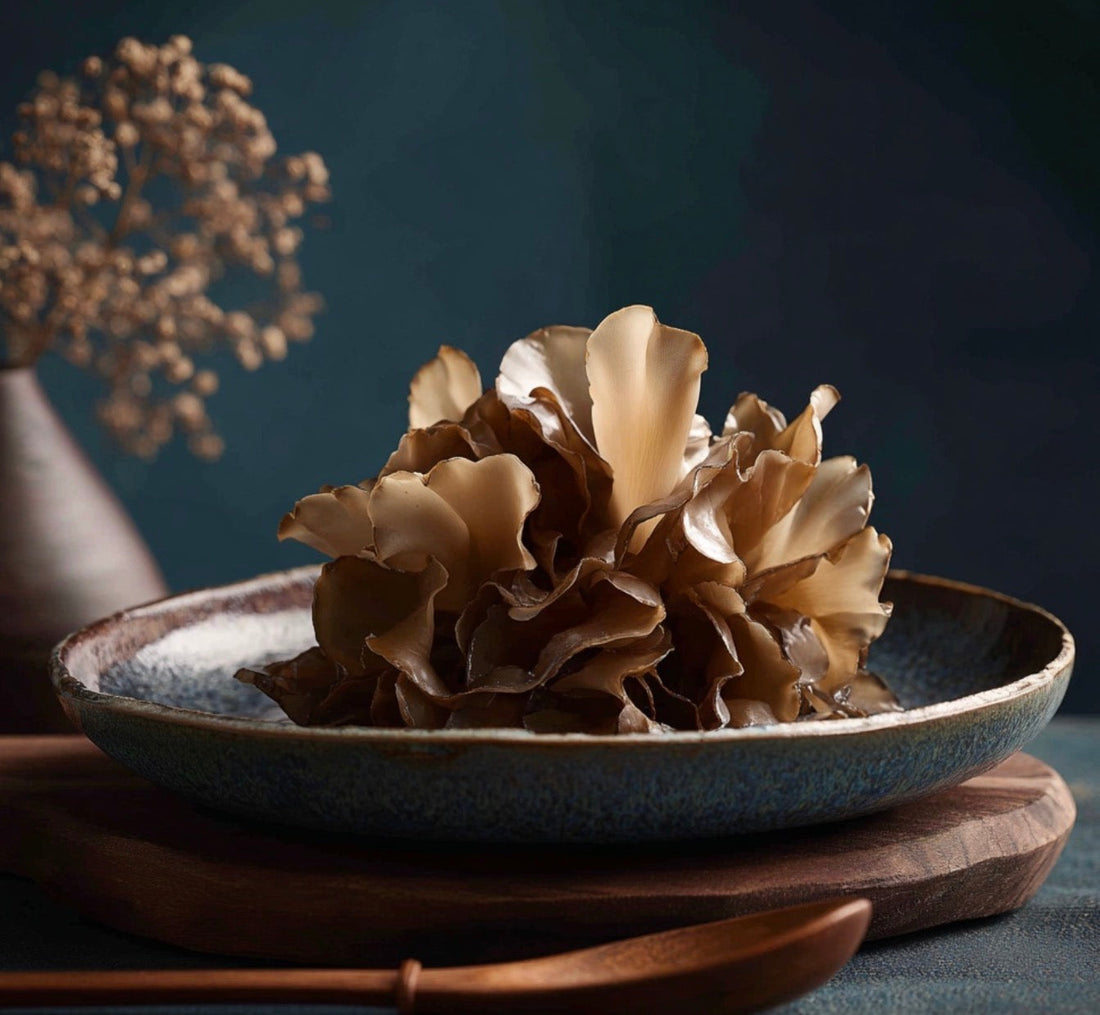
Wood Ear Mushroom Cholesterol Benefits: A Heart Health Guide
08/27/25Share
Unlocking Heart Health: Can Wood Ear Mushroom Lower Your Cholesterol?
Published on August 23, 2025
Article Summary
This guide explores the powerful connection between the **wood ear mushroom and cholesterol** management. We'll examine its nutritional benefits, scientific backing, and how to safely add it to your diet for better heart health.
I. Introduction: Meet the Mushroom with a Mission
Have you ever considered that the secret to a healthier heart might not be in a pill bottle, but in the fungal kingdom? Let's introduce the wood ear mushroom—a jiggly, crunchy delight also known as cloud ear or black fungus. While it has been a culinary staple for centuries, emerging science is exploring the link between the **wood ear mushroom and cholesterol**, suggesting it could be a powerful ally for your heart.
II. What's So Special About Wood Ear?

The wood ear mushroom's unique appearance—dark brown and ear-shaped with a gelatinous texture—is matched by its impressive nutritional profile. It's a culinary chameleon, absorbing the flavors of any dish while providing key nutrients.
Nutritional Powerhouse:
- Low Calorie & Low Fat: An excellent choice for weight management.
- Rich in Fiber: Packed with beta-glucans, a type of soluble fiber strongly linked to lowering cholesterol.
- Essential Minerals: A good source of iron, calcium, and potassium.
- Antioxidants: Contains polyphenols that help fight oxidative stress in the body.
Remember, these mushrooms are almost always sold dried and **must be rehydrated and thoroughly cooked** before eating.
III. A Trip Through Time: Ancient Wisdom
The use of wood ear mushrooms stretches back centuries. In Traditional Chinese Medicine (TCM), it has been revered for over a millennium to "activate blood flow" and "cleanse blood vessels," directly connecting it to heart health and circulation. This ancient wisdom laid the groundwork for modern scientific inquiry into **wood ear mushroom cholesterol** benefits.
IV. Modern Science and Wood Ear Mushroom Cholesterol Benefits

While more human trials are needed, current research is promising. Animal studies have shown significant drops in "bad" LDL cholesterol and total cholesterol in subjects fed a diet including wood ear mushrooms.
How Does It Work?
- Fiber Power: The high concentration of beta-glucans binds to cholesterol in the digestive system, preventing its absorption into the bloodstream.
- Bile Acid Excretion: It helps the body excrete bile acids, forcing the liver to use up existing cholesterol to make more, thereby lowering overall levels.
- Antioxidant Defense: Its polyphenols may help reduce the oxidation of LDL cholesterol, a key step in the development of atherosclerosis (hardening of the arteries).
Medical experts view the connection between **wood ear mushroom and cholesterol** with cautious optimism, agreeing it's a healthy addition to a balanced diet but not a replacement for conventional medicine.
V. Handle with Care: Safety Precautions
To safely enjoy the benefits of wood ear mushrooms, follow these critical rules:
- Always Cook Thoroughly: Never eat raw wood ear. Soaking and cooking are essential to eliminate bacteria.
- Proper Soaking is Key: Improperly soaking for too long in warm water can create a rare but serious toxin. Soak in cool water for 2-3 hours and discard the water.
- Consult Your Doctor: Due to its natural anticoagulant properties, you must talk to your doctor before consuming it if you are on blood thinners like warfarin.
VI. The Future is Fungus

The future for the **wood ear mushroom and cholesterol** research is exciting. We can expect more rigorous human trials and the development of standardized extracts for use in functional foods and supplements, making its heart-healthy compounds more accessible to everyone.
Frequently Asked Questions
How much wood ear mushroom should I eat for cholesterol benefits? +
While there's no official dose, incorporating about a half-cup of cooked wood ear mushrooms into your meals 2-3 times a week is a reasonable and safe amount to potentially see heart health benefits as part of a balanced diet.
Can wood ear mushroom replace my statin medication? +
Absolutely not. Wood ear mushrooms should be considered a complementary dietary addition, not a replacement for any prescribed medication. Never stop or change your medication without consulting your doctor.
What's the best way to cook wood ear mushrooms for heart health? +
Lightly sautéing, stir-frying, or adding them to soups are excellent methods. Avoid deep-frying, as this adds unhealthy fats that counteract the cholesterol-lowering benefits. The key is to cook them thoroughly after rehydration.
Are there any risks for people with diabetes eating wood ear mushrooms? +
Wood ear mushrooms may have a modest effect on blood sugar levels. If you have diabetes, especially if you are on medication, it's wise to monitor your blood sugar when you first introduce them and discuss it with your healthcare provider.
Where can I buy safe, high-quality wood ear mushrooms? +
Look for dried wood ear mushrooms at reputable Asian markets, larger grocery stores with international food sections, or trusted online retailers. Choose packages that are well-sealed and free from signs of moisture or mold.
What does "beta-glucan" do for cholesterol? +
Beta-glucan is a type of soluble fiber that forms a gel-like substance in your digestive tract. This gel traps cholesterol and bile acids, preventing them from being absorbed by the body and helping to excrete them as waste. This is a primary mechanism behind the **wood ear mushroom cholesterol** effect.
Can I grow my own wood ear mushrooms at home? +
Yes, wood ear mushrooms are relatively easy to cultivate at home using grow kits, which typically come with an inoculated substrate (like a log or sawdust block). This can be a fun way to ensure a fresh, safe supply.
What's the difference between wood ear and other mushrooms like shiitake for heart health? +
While many mushrooms are healthy, wood ear is particularly noted for its high fiber content and unique gelatinous texture. Shiitake mushrooms contain a compound called eritadenine, which also helps lower cholesterol through a different mechanism. Both are excellent choices for a heart-healthy diet.
How do I properly rehydrate dried wood ear mushrooms? +
Place the dried mushrooms in a large bowl and cover them completely with cool or lukewarm water. Let them soak for 2-3 hours, or until they are fully expanded and soft. Drain them, rinse thoroughly, and trim off any tough, gritty parts at the base before cooking.
Are there any side effects to eating wood ear mushrooms? +
For most people, when properly cooked, there are no side effects. The most common issue is digestive discomfort (gas or bloating) if you eat too much, due to the high fiber content. The main serious risk, bongkrekic acid, is avoided by following proper, cool-water soaking procedures.
What other foods pair well with wood ear mushrooms in a cholesterol-conscious diet? +
Pair them with other heart-healthy foods like garlic, ginger, leafy greens (bok choy, spinach), lean proteins (tofu, chicken, fish), and whole grains (brown rice, quinoa). These combinations maximize nutritional synergy and support your goals for managing **wood ear mushroom cholesterol** levels.
Is there a difference between "wood ear," "cloud ear," and "black fungus"? +
These names are often used interchangeably, but they can refer to slightly different species within the *Auricularia* genus. For culinary and general health purposes, their properties are very similar. "Wood ear" (*Auricularia auricula-judae*) is the most common variety discussed for its health benefits.




